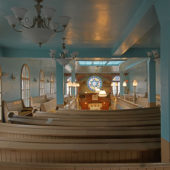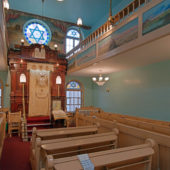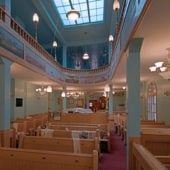Oldest synagogue in Quebec at its original location.
Montreal’s Bagg Street Shul started out as a two family residence constructed in 1899. The building was enlarged and converted from a duplex to a synagogue in 1920-21, and has been in continuous use since then.
Situated at the corner of Clark and Bagg streets, this synagogue (now Beth Shloime Temple Solomon) is the oldest in Quebec to have kept its original location and congregation. Despite its official heritage designation in 1998, the synagogue’s small membership has struggled to meet operating expenses and keep the building in good repair.
In recent times, the Religious Heritage Foundation of Quebec (which is dedicated to preserving religious buildings of historical merit) came to the rescue, designating $230,000 for the Bagg Street Shul. This allowed needed repairs to be made to the windows and roof. Plumbing, heating and cooling systems also were upgraded.
The unassuming, two-story, red brick structure once was just one of as many as 27 synagogues located in old Montreal. However, the departure of the area’s Jews to other parts of the city and beyond, starting in the 1960s, resulted in the closure of most synagogues. The Bagg Street Shul had a thriving congregation of 125 members during the 1920s when the area was a bustling textile center featuring many street signs in Yiddish. The synagogue itself had a capacity of about 350 people.
A small Star of David sits atop the archway entrance and its Hebrew inscription while windows on either side of the doorway also feature Stars of David in stained glass. The interior is laid out in classic Ashkenazi style, with the ark placed at the back of the building, a central bimah, and balcony for women. Daylight pours through a large skylight in the roof into the synagogue’s interior while the Star of David again figures prominently in the large round window above the carved wooden ark.
The ark and pews were acquired from another local synagogue, Shaar Ha Shomayim when that congregation built a new facility. The synagogue walls are painted in a light, or sky blue, while the perimeter of the balcony below the balustrade depicts individual scenes of animals ranging from the American Bison and antelopes to lions, scorpions and other creatures, some with accompanying Hebrew inscriptions.
Interestingly, though the congregation during the synagogue’s busiest era was largely Ashkenazi (probably of Russian origin), a cornerstone plaque identifies the synagogue as anshei sepaharad (people of Spain). Apparently, Sephardic practices were incorporated into worship rituals. Today, the small orthodox synagogue finds its numbers boosted occasionally by Jewish students from three nearby colleges who frequent the building for worship services on holidays.
Quebec’s Jews have enjoyed a largely peaceful and prosperous existence since 1760 when the arrival of English authority ended the ban on non-Catholics residing in Montreal. History records that Aaron Hart, was the first Jewish settler to arrive in Montreal and the first synagogue was constructed in the city in 1777.






